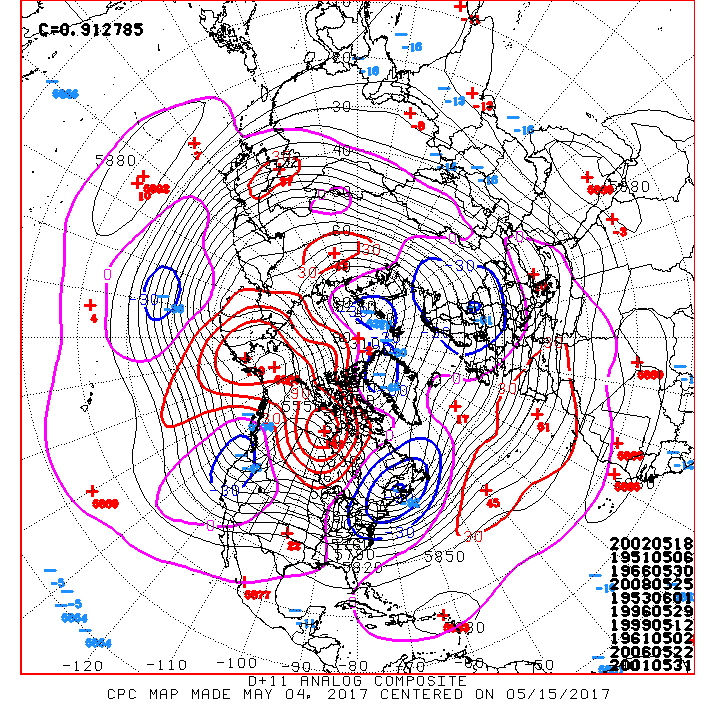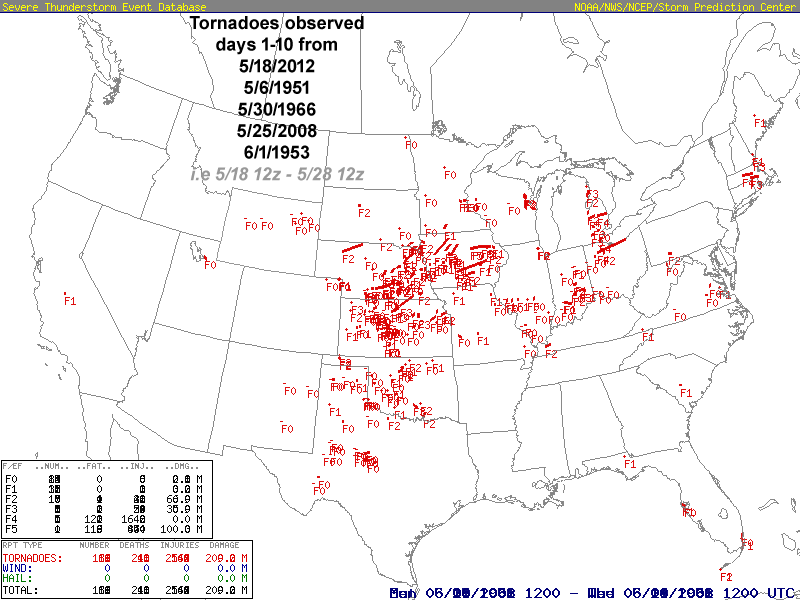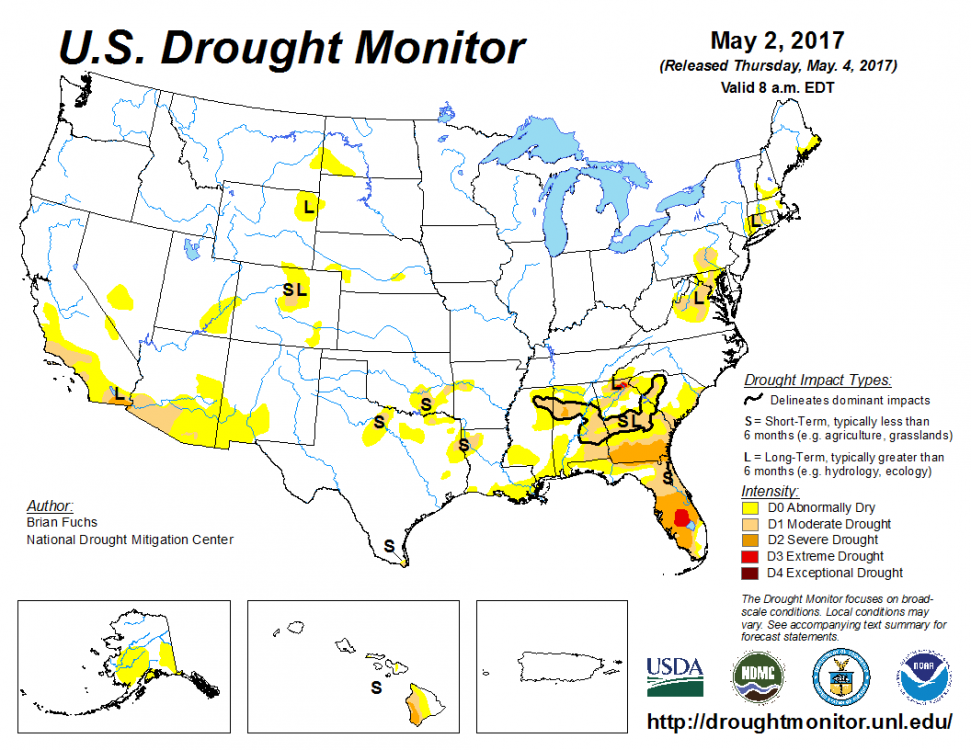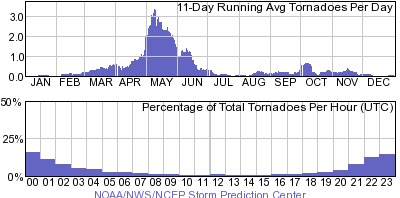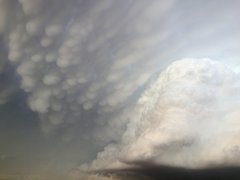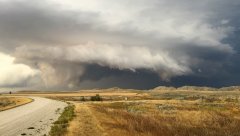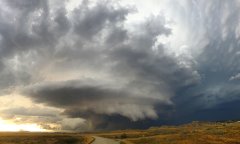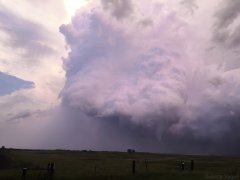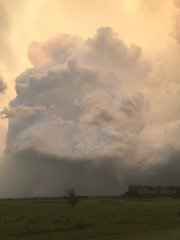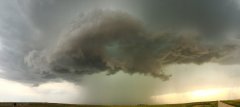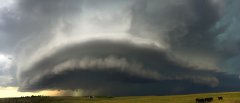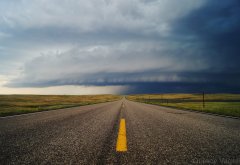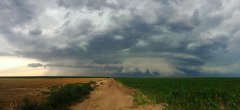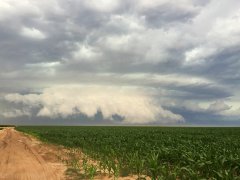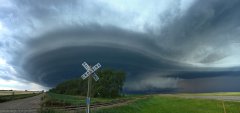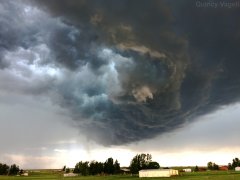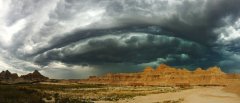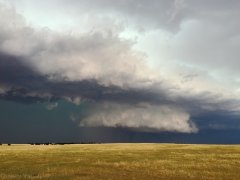-
Posts
6,220 -
Joined
-
Last visited
Content Type
Profiles
Blogs
Forums
American Weather
Media Demo
Store
Gallery
Everything posted by Quincy
-
Not sure if it's accurate, but M40 just shot up to 70/70 on the latest ob. Seems suspect. Tupelo was 58/57 at the top of the hour, so that cluster is likely on a track just north of the warm front based on the current storm motion, at least in the short term.
-

Central/Western Medium-Long Range Discussion
Quincy replied to andyhb's topic in Central/Western States
I don't know about moisture recovery not being an issue with the upcoming systems. The 12z Euro looks awful tame now with 60F dews staying south of the Red River on Sunday and struggling to reach into Arkansas on Monday. The overall pattern is too messy, especially for March, given such a large trough over eastern North America. With relatively small systems reoccurring in a fast-flow pattern, there isn't much reason to believe there will be substantial moisture recovery. More of a robust south/southeasterly wind trajectory over the southern Plains/lower Mississippi Valley is needed than what is progged with the expected pattern. If it was later in the season, it wouldn't take as much to moisten the warm sector, but we're only in mid-March and next week doesn't look too promising. I wouldn't be overly concerned though, as it is barely meteorological spring and not even the spring equinox yet. I wouldn't rule out some spotty severe next week and maybe the evolution of one or two of the systems will improve, but it definitely does not look like an outbreak setup and doesn't even look like a scenario for anything impressive for mid-March standards. -

Central/Western Medium-Long Range Discussion
Quincy replied to andyhb's topic in Central/Western States
The 00z 3km NAM wasn't impressive at all, showing substantial cloud-cover ahead of the dryline with surface temperatures 5-10F shy of convective temperatures, even in the vicinity of a dryline bulge in the eastern Texas panhandle. Reflectivity progs concur with no convection. Meanwhile, the GFS came in a bit warmer in the western Oklahoma to central Kansas region, although still not quite robust enough for convection. I was intrigued to see the RGEM spit out convection in far southwestern Oklahoma between 21z Sun and 00z Mon. It makes sense based on what appears to be surface temperatures heating into the mid-70s in the presence of upper 50s to near 60F dew-points. I am still inclined to lean toward a non-event with cloud-cover mitigating surface heating (poor sfc-850mb lapse rates), despite favorable wind fields and nice looking thermodynamic profiles above 800mb. A highly conditional threat could still produce if surface heating improves, so I'd hold with a MRGL risk outlook for tonight's day 2 update. -

Central/Western Medium-Long Range Discussion
Quincy replied to andyhb's topic in Central/Western States
The main limiting factor appears to be the quality of the warm sector. As discussed above, only a narrow area around the southwestern Oklahoma vicinity is progged to have (somewhat) favorable low level moisture, along with at least a possibility of convective temperatures being approached. The issue is that even within NAM range (taken with a large grain of salt at 72hrs), only a very tiny area (1-3 counties) comes within a couple of degrees of convective temperatures. The 00z NAM also shows no convection along the dryline. In addition, the NAM, too, favors the idea of >75% cloud cover across areas east of the dryline in Oklahoma. Synoptically, Sunday resembles 2/28/12, however, the warm sector this weekend is significantly smaller and far less impressive. If we had a deeper trough, a la 2/23/07, better forcing and mid-level cooling would result in much greater certainty of convective initiation along the dryline. Even the evolution of the surface low is not entirely clear. The 12z ECMWF shows a 995mb low up near I-80 in central Nebraska at 00z Mon, while the operational NAM still shows a focused low over western Kansas at the same time. The 18z GFS was somewhere between, while the 21z SREF shows substantial variability, ranging from an OP NAM solution to a more elongated low over the mid-Missouri Valley/Siouxland. Once we get into higher resolution model range and the operational models have some time to converge on a solution, then confidence may increase. Right now, the severe threat appears fairly conditional and perhaps more than one would expect for such a scenario in early March. The ongoing drought and (expected) relatively meager warm sector don't help matters either. As stated in the previous reply, the forecast shear profile won't need much to take things off. The low level thermodynamics just need to be improved... -

Central/Western Medium-Long Range Discussion
Quincy replied to andyhb's topic in Central/Western States
Where are you seeing lower 70s on the GFS with upper 50s dew-points and minimal capping? That was my main point. -

Central/Western Medium-Long Range Discussion
Quincy replied to andyhb's topic in Central/Western States
Regarding moisture... notice how the dryline surges east on the GFS, outrunning the greatest surface heating, leaving only a narrow sliver of favorable low-level temperatures and moisture. Even though progs are in the ballpark of 70/60 near the Red River, warming around 850mb results in a sizable capping inversion, especially south of the KS/OK border. For reference, readings are in Celsius on this map, where 20C = 68F. -

Central/Western Medium-Long Range Discussion
Quincy replied to andyhb's topic in Central/Western States
A 995mb low in western Kansas would be much more interesting even just a month from now. Still, cold air aloft is promoting some fairly steep lapse rates in the model progs, along with modest instability. Low level moisture looks better across the southern High Plains, but forcing will be weaker there, along with less steep mid-level lapse rates. Moisture looks awfully marginal (low to perhaps mid-50s) in western/central Kansas, but lapse rates become quite steep (8-9C/km) closer to the surface low, where forcing will be maximized. We are getting into March, so it wouldn't be completely uncharted territory for some severe hail in the area. Anything beyond that seems too early to speculate at this point. -

Central/Western Medium-Long Range Discussion
Quincy replied to andyhb's topic in Central/Western States
Aside from some pronounced western CONUS ridging in the June 16-21 window, today's new Euro weeklies suggest that the late June to early July period stays relatively active in the north-central states. Yes, the severe season south of I-80 should largely be done after next week, but that's climo for you. After mid-June it's pretty tough to get anything significant in Kansas and points south, barring some anomalous trough or unusual mesoscale accident. As for ridging, the weeklies keep that across the southern tier with generally AOB average 500mb heights across Montana/Dakotas into at least the first third of July. -

Central/Western Medium-Long Range Discussion
Quincy replied to andyhb's topic in Central/Western States
Addressing the 500mb wind threshold, the median value for northern Plains significant tornadoes in the summer is about 40 knots (Grams et. al 2011), with less than 25% of significant tornado cases featuring 500mb winds below 35 knots. With that said, Chapman (5/25/16) was associated with 31 knots of h5 flow (00z TOP) and the northeastern Nebraska tornadoes of 6/17/14 also saw about 31 knots, based on the 00z OAX sounding. Dodge City's 19z sounding from 5/24/16 sampled 36 knot winds at h5. Bowdle was much stronger at 500mb with 52 knots sampled by the 00z ABR sounding. I prefer 30 knots at 500mb as a lower bound for tornado favorability, but would like to see at least 40 knots. Substantial 0-3km SRH (and/or extreme instability) can make up for otherwise marginal 500mb speeds, but I can't immediately come up with any long-track tornadoes that occurred with <30 knot winds at h5. -

Central/Western Medium-Long Range Discussion
Quincy replied to andyhb's topic in Central/Western States
Agree with the points above. If I had Friday off, I'd venture north, but I concur that this weekend not a setup to make a long haul out for. I'm taking the down time to get work in, as we may have a lengthy active stretch coming up. Saturday may end up being an in between day before the late weekend/early next week pattern looks to feature at least a couple of solid severe potential days. The 00z Euro was very encouraging, but remember that models will adjust a bit in the medium range, so details are TBD. Speaking of models, the CFS has been consistent in showing a sharp turn around in the pattern. While high-end days don't seem likely, it appears that down days next week will be more the exception than the rule. While the CFS has little to no skill over climo beyond day 10 (so don't get too excited about the second half of June being a blockbuster period just yet), in my experience, it's quite good at general patterns inside of 7 days. For positioning, it looks like a bit of a late June/early July-like period with the northern Plains/upper Midwest being the favored areas. You may see some threats shift east into the Great Lakes vicinity, while capping becomes a big concern with southward extent over the Plains given the strength of a ridge over the South. -

Central/Western Medium-Long Range Discussion
Quincy replied to andyhb's topic in Central/Western States
The next week or so looks like a continuation of the pattern. It's fairly unusual to observe such a long period like this given the time of year to see the Plains so quiet. (We will probably end up with a 2-3 week run featuring substantially below average tornado activity during the climatological annual peak of late May/early June) Aside from a few tornadoes in the western part of the state, Oklahoma gets off the hook again without much substantial tornado activity, despite a few "higher-end" threats in the state to finish off May. The longer range guidance seems to be zeroing in on some pattern improvement by late next weekend or early the following week (beginning in the June 11-13 period), but given fairly prominent ridging over the Midwest, the area of focus may end up being from the northern High Plains into the Dakotas. While this is not completely unheard-of for June, it may mean a rare quiet spell for Kansas continues. Despite the above-average tornado activity, places like Kansas and Oklahoma have been relatively quiet. I guess all of the early season tornadoes in the Southeast and some increased activity in Texas account for much of the tornadoes so far this year. It's also been a year largely void of long-track and/or photogenic tornadoes. Going back to the quote above, weather likes to balance out in the long run. Aside from April 27-28, 2014 featured a putrid tornado season until a stretch in mid-June. While I remain cautiously optimistic, any such pattern change remains to be seen. Will it be dampened out? Will trough ejections be displaced too far north? Will the change continue to be pushed back later and later in June? Only time will tell. -

Central/Western Medium-Long Range Discussion
Quincy replied to andyhb's topic in Central/Western States
Confidence in this range is relatively good through day 10 and just wow. There were hints from a few weeks out that this period would improve, but now that's far from the case. This may be one of the worst late May/early June stretches (at least for photogenic and/or longer-lived tornadoes) for tornadoes in a while. Yes, there were a few events and some local accidents, like Wisconsin, but otherwise it's largely been a dud in the Plains. Bigger days have largely been busts or filled with messy storm modes. There have been very few long-lived supercells over terrain west of I-35. Most events (from a chaser/photographer perspective) have been "right place at the right time," otherwise a lot of hair pulling, highly challenging events The last couple of CFS runs are as quiet for a 7-10 stretch as they have been since early May. The support across the board is fairly consistent with general troughing in the East and few, if any notable shortwaves impinging on the Plains. As we move into June, you'd expect that eastern Colorado and vicinity will have a few events (even with marginal/questionable environments) and northwest flow can eventually be more meaningful in terms of severe across the Midwest/Great Lakes as the calendar shifts deeper through June, otherwise, it looks like a snoozefest. There's always the potential for a mesoscale accident, but... -

Central/Western Medium-Long Range Discussion
Quincy replied to andyhb's topic in Central/Western States
The overall CONUS pattern looks favorable for really the balance of May. That may not be saying a lot (as the period is active in most years), but general troughing in the West should allow fairly steady shortwave ejections into the Plains over the final 10-15 days of May. It's really a solid looking pattern for at least near average severe activity as we near the climatological peak of the season. The potential exists for a couple of bigger days, as one would expect with such a pattern, if things line up just right There has been volatility in the ensembles regarding the final days of May into early June, where the Euro weeklies suggest there may be a bit of a lull. I'm not too concerned about anything beyond week 2, as things could change substantially. Nonetheless, a relatively active pattern not only next week, but probably the week following should be on tap. -

Central/Western Medium-Long Range Discussion
Quincy replied to andyhb's topic in Central/Western States
A pattern flip is certainly plausible. I wouldn't be surprised if late May is rather active. With that said, seasonable activity in comparison to the current state of affairs would seem like a big difference. It's hard to screw up late May unless you get a bizarro cutoff low over the Ohio Valley, or massive ridge over the Rockies. -

Central/Western Medium-Long Range Discussion
Quincy replied to andyhb's topic in Central/Western States
I've taken a bit of a deeper dive into the medium-long range period and based on trends, model guidance and climatology (analogs), it seems probable that the next 2-3 weeks will feature below average tornado activity. Additionally, we may continue to see typically active areas in early/mid-May (North Texas, central/eastern Oklahoma, eastern Kansas; Missouri) remain very quiet. Global guidance is consistent in showing an omega blocking-type pattern through at least the start of next week. This will mean that favorable upper level flow will remain largely split away from the Plains, with a seasonably strong northwest jet from the Midwest/Great Lakes into the Southeast and similarly strong upper level flow across the western United States (transitioning more toward the Desert Southwest by the end of the weekend). Aside from sporadic severe (mainly damaging winds) across the West and East Coast, this looks like about as benign of a pattern as one could draw up for the first 5-10 days of May. Going forward, there is some potential for severe threats to materialize across the southern/central High Plains during the first half of next week, as a cutoff low ejects east from the Four Corners region. Kinematic and thermodynamic fields don't look particularly impressive, especially not for mid-May, although it's likely that tornado activity ticks up a bit next week. My main focus is on the period beyond that. Does this month get out of this seemingly extended early May dearth of tornado activity? Probably not, at least not in any big way. I took a look at two main model projections, the CPC day 8-14 analogs and the new Euro weeklies, which were released within the past few hours. The signal from both camps is more or less the same. The CPC analogs are centered on May 15th and I took the top 5 analogs and ran out tornado counts from days 1-10 in those periods for a comparison. The analog days 1-10 period averaged 55 tornadoes, which is well below the average of 79 for May 15-24. Also, the focus for tornado activity is centered across Kansas/Nebraska/Iowa, which fits the weeklies progs very well. The pattern is projected to feature some troughing over the Great Basin, with a tendency for shortwaves to transverse the central Plains to upper Mississippi Valley. (The period starts with a "death ridge" across the Plains, before the pattern becomes less ugly with time) That would tend to favor severe in the central Plains, which means the May tornado season could effectively "skip over" the Oklahoma/southeastern Kansas/Missouri area. There are at least some instances of tornadoes across the southern High Plains into Oklahoma in these analog periods, but the likelihood of a deep trough bringing substantial tornado threats to the southern Plains through weeks 2 and 3 of May seems fairly low. Overall, the analogs and medium-long range guidance both support below average tornado activity across the Central United States over the next 2-3 weeks, with at least some potential for near/somewhat above average activity in the central Plains/middle Missouri Valley. (Don't count out the southern High Plains early next week) It will be mid/late May, so you can't rule out a bigger event that could throw a wrench in this thinking verifying, but the odds seem lower than 50/50 on such a scenario, which is also climatologically abnormal. It was going to be difficult to bring this year's tornado count back to seasonable levels after such a busy early season, but a below (if not well below) average May could manage to achieve that. -

Central/Western Medium-Long Range Discussion
Quincy replied to andyhb's topic in Central/Western States
On the bright side, recent heavy precipitation events have wiped out almost all drought areas across the central United States: -

Central/Western Medium-Long Range Discussion
Quincy replied to andyhb's topic in Central/Western States
April is hit and miss for Oklahoma. It seems like occasionally there are some big early season events, offset by plenty of years with little action in April. The April average of 11 tornadoes for Oklahoma jumps to 28 in May, but you can see the graph for central Oklahoma spikes sharply into May. On the other hand, we've seen one of the busiest Jan-Apr tornado periods in recent memory across the Gulf Coast states. Overall, we're still well above average year-to-date, but low severe activity through at least the next 5-7 days will probably move us back to near average in terms of tornadoes. -

Central/Western Medium-Long Range Discussion
Quincy replied to andyhb's topic in Central/Western States
Current trends and analogs suggest severe threats may return by the middle of next week across the southern High Plains, to perhaps as far north as eastern Colorado, as that cutoff low ejects east. Until then, I'll be working extra, unanticipated hours to save up more for prime chase season. Even if things don't line up ideally next week, we're getting into the part of the season when it's harder for such troughs to not produce at least a few tornadoes. -

Central/Western Medium-Long Range Discussion
Quincy replied to andyhb's topic in Central/Western States
What a hostile setup for central U.S. severe potential through at least the first week of May and quite possibly through much of the first two weeks. The relative dearth of severe potential has been consistently modeled for quite some time now. There were some hints about pattern changes into the second week of May a few days ago, but that potential seems to be dialing back as well. The pattern favors two cutoff lows effectively shutting down any significant severe threats in the Plains over the next 7-10 days. The lead low works to scour rich, Gulf moisture, as the 12z ECMWF struggles to bring >50F dew-points north of Oklahoma through 240 hours. There are only a few panels in which low to mid-50s dews squeak into parts of Kansas. That's quite a feat to keep the central Plains that consistently dry through the first 7-days of May, especially given excessive, antecedent rainfall across a broad portion of the central United States. Back west, while modeling showed western U.S. troughing for a while, such a trough may result in a meandering cutoff low over Southern California. Such a low remains too far west for any appreciable large-scale forcing across the Plains. Some analog guidance has hinted at some potential across the southern/central High Plains later in the day 6-10 period, where upslope flow can work to offset otherwise seemingly marginal (at best) low-level moisture. Outside the sub-forum, this pattern could yield some severe potential from the eastern Gulf Coast states into the Carolinas. As we know, forecasts for a week out can significantly change. Look out to day 10 and beyond, and sometimes the model progs end up being way off, as patterns evolve much differently than expected. Nonetheless, barring some sort of mesoscale accident or extreme model error, this upcoming week looks about as dead as it could possibly be across the Plains with respect to severe potential in May. It's been mentioned before and it's actually fairly common to see a bit of a severe lull in early May. The difference here is that the medium-range pattern looks so hostile for severe, that we may see little to no severe thunderstorm activity in the Plains for quite some time. The only day of slight interest this upcoming week looks to be on Tuesday, where there could be some modest severe potential across Oklahoma. Such a setup will revolve around a lot of ingredients coming together, as the synoptic scale pattern does not look particularly favorable. -

Central/Western Medium-Long Range Discussion
Quincy replied to andyhb's topic in Central/Western States
Nothing stands out in the next 10 days. That's not to say you can't get a mesoscale event or two, or perhaps some change in the pattern, otherwise it looks like a relatively quiet mid-April stretch. -

Central/Western Medium-Long Range Discussion
Quincy replied to andyhb's topic in Central/Western States
Those cells look to be east of the instability axis and are moving into a region with considerable CINH. Some cu is spitting off the dryline in western OK, but even there, at least some capping is holding on. -

Central/Western Medium-Long Range Discussion
Quincy replied to andyhb's topic in Central/Western States
The lack of more turning with height seems to be the biggest red flag. Steep lapse rates are there and both the EC and NAM erode the cap by 00z. EC also favors a discrete storm mode as well. Although moisture is better than some recent events, the EC favors near 60F dews, as opposed to the more bullish NAM. This, along with veered flow/largely unidirectional wind fields aloft points toward a marginal tornado threat at best. Mixed signals here, but a lower end severe (mainly hail) event seems most reasonable, unless things trend in another direction soon. Not unusual at all for early April, but not particularly impressive either. -

Central/Western Medium-Long Range Discussion
Quincy replied to andyhb's topic in Central/Western States
It's still a long way out, but have to wonder if Thursday may feature an early season west-of-I-35 threat from the Texas panhandle into the central Plains. Wind fields strengthen ahead of a trough ejecting east from the Desert Southwest. Even the Euro shows an area of mid to upper 50s dews with convective precip ahead of a dryline. The quality of moisture return appears to be the biggest question at this stage. Friday seems like the best threat day at this point, especially if models slow down a bit more as they already have over the past few days. -

Central/Western Medium-Long Range Discussion
Quincy replied to andyhb's topic in Central/Western States
It's still early in the season. It's not particularly common for events in the Plains or Ohio Valley through about mid-March, aside from outlier outbreaks. Limited moisture is a glaring issue, unless you get a string of anomalously strong surface lows diving north into the Upper Midwest. The early signs have been encouraging at the least. While we may quiet down a bit upon finishing up February, I am looking ahead in a cautiously optimistic manner. About two months into the year, we've seen the most early season tornadoes since 2008. Even if we flatline for the next two weeks, we'll still be above climo, year-to-date. -



